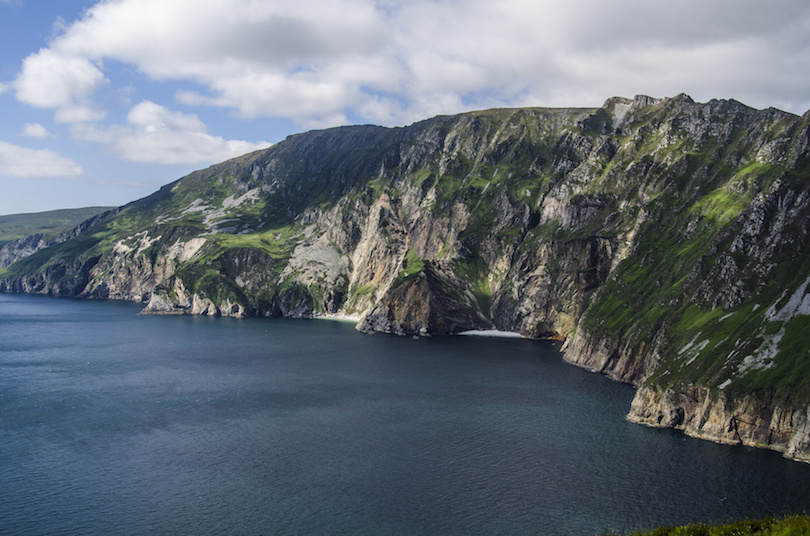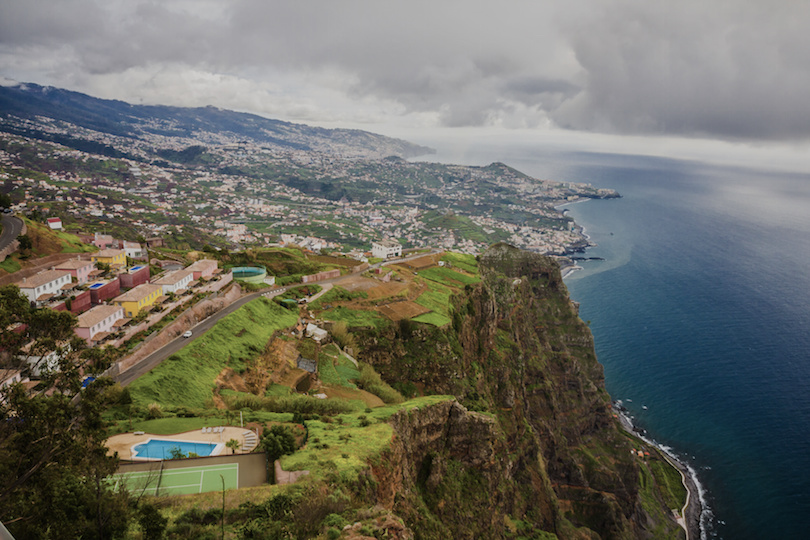Nothing creates a better “End of the World Experience” than the dramatic coastlines formed by vertical sea cliffs. Standing on top of these tall cliffs, your eyes are met with nothing but the vast expanse of the ocean, huge waves crashing against the rocks below.
18. Sagres
Sagres, located on the western Algarve Coast in Portugal, is a sight to see, with its impressive cliffs that were carved by raging seas and high winds. The deep blue Atlantic Ocean only accents the scenic beauty of Sagres. The isolated beaches seem deserted, especially when compared to other areas of the Algarve. The ocean spawns some pretty fantastic waves, making Sagres popular with surfers who can enjoy cliff views on the way in.
17. Skansbukta
Visitors to the cliffs at Skansbukta, Svalbard will have a chance to revisit history while enjoying looking at the barren cliffs, which stand out from a lush landscape. The area was once home to a gypsum mine, with artifacts from that era found on the beach; a trapper’s cabin also is located here. Because of the danger from falling rock, visitors are advised not to try and climb the cliff from the beach side. A journey over the water is the best way to reach here.
16. Qingshui Cliffs
Qingshui Cliff is so spectacular the Taiwanese government considers it one of the island nation’s eight wonders. Stretching for 13 miles along the Pacific Coast, the cliffs rise to heights of more than 800 meters. Made up of marble and gneiss, the cliffs are on the only coastal road through Tanoko National Park. The southeastern side of Mt. Qingshui is the steepest cliff. A new tunneled highway replaced the old road, which has been turned into a walking path.
15. Dingli Cliffs
Dingli Cliffs, found on the west coast of Malta, are the highest point in the Maltese islands. Though only 250 meters (830 feet) high, the cliffs are best viewed from a boat, but those who climb up to the cliffs will be rewarded with stunning vistas of the surrounding area; sunset is a particularly good time to see the cliffs. They’ll also find a small chapel dedicated to St. Mary Magdalene on the cliff’s edge.
14. Mitre Peak
At 1,690 meters tall, Mitre Peak is the highest sea cliff in the world, with other cliffs in the sound ranking among the world’s highest. Located on the South Island’s Milford Sound, it is one of the most photographed mountains in the sound. The mountain resembles a bishop’s hat, which is how it acquired the name “Mitre.” A boat tour is a popular way to see Mitre’s sea cliffs. Mitre Peak actually is a close grouping of five peaks that seemingly blend into one.
13. Hornelen
The Hornelen mountain in Norway promises stunning views from either the top or in a boat cruising through Norway’s fjords. At 860 meters high, this majestic sea cliff is the highest in Europe. It’s possible to hike to the top of the cliff, but travelers should be forewarned the trek is only for seasoned hikers as it is steep and challenging. Couch potatoes and others may want to see it from a boat. Not only does Hornelen, located in Bremangerlandet Island, offer unique scenery, the cliff also is used in naval navigation.
12. Slieve League
The cliffs at Slieve League are an imposing 601 meters tall, making them one of the highest in Europe. Located in County Donegal in Ireland overlooking the Atlantic Ocean, the cliffs are more accessible than some, since it’s possible to drive to the viewing area, but only experienced hikers should venture past the viewing point. Remains of an early Christian monastery can be found along the way.
11. Cape Enniberg
Cape Enniberg sits on the northernmost tip of the Faroe Islands. It stands almost 750 meters high on Viboy Island. It’s possible to hike to the top if hikers are highly experienced and have a guide, but anyone who attempts this should know that heavy fogs roll in without warning. Boat excursions to the cape are available in summer. The cape is home to an important bird colony, so travelers should bring binoculars.
10. Etretat
Étretat is a small coastal village in France best known for its cliffs, including a famous natural arch. The spectacular sea cliffs and the associated resort beach attracted famous artists including Gustave Courbet and Claude Monet. The pebbled beach, sparked with quartz geodes, is wrapped in dramatic cliffs eroded into giant formations and offshore needles. Two of the arches can be seen from the town, a third requires a walk at low tide.
9. Paracas Sea Cliffs
Paracas National Reserve is a popular nature reserve and beach destination on the southern coast of Peru. The reserve is home to many species of wildlife, particularly birds, whom are largely concentrated at the water’s edge. The sea cliffs that fringe the beaches provide home to thousands of these. A trip to Paracas is not complete without a visit to scenic Playa Roja or Red Beach named after the rend sand of volcanic origin.
8. White Cliffs of Dover
The White Cliffs of Dover spread east and west from the port town of Dover. The cliffs have great symbolic value for Britain because they face towards France across the narrowest part of the English Channel, where invasions have historically threatened and against which the cliffs form a symbolic guard. The cliff face, which reaches up to 107 meters, owes its striking white color to its composition of chalk accentuated by streaks of black flint.
7. Látrabjarg
At 14 km long and up to 440 meter high, Látrabjarg is one of the three largest bird cliffs in Iceland, with the other two being Hornbjarg and Hælavíkurbjarg. Látrabjarg is by far the easiest of the three to visit as a road leads practically to the cliff’s edge. It is fitting that Látrabjarg itself is at the end of a road, as it marks the end of a continent marking the most western part of Europe.
6. Bunda Cliffs
The Bunda Cliffs are just one of the many dramatic sea cliffs of Australia’s long coastline. Bunda Cliffs is an aboriginal name used for the Nullarbor coastal cliffs. The sea cliffs, which are some 60 to 120 meters high, extend for around 100 km along the Great Australian Bight near its northern extremity and are close to the Nullarbor Plain in a very sparsely settled area of Australia. Besides cliffs, the coast line of the Great Australian Bight is characterized by surfing beaches and rock platforms, ideal for whale-watching.
5. Cabo Girao
Cabo Girão is located in the southern part of the Madeira Islands. At 570 meters, the cliff is often referred to as the highest sea cliff in Europe but at least three European cliffs are higher. The view down the almost sheer drop to the ocean is thrilling nonetheless. The terraced fields that can be seen beneath the cliff used to be only accessible by boat. In 2003, a cable car was installed on the slope of the cliff so farmers can reach these low-lying fields.
4. Acantilados de Los Gigantes
Acantilados de Los Gigantes (“Cliffs of the Giants”) are sea cliffs along the western coast of the Canary Island Tenerife. The almost vertical walls reach heights of 500 meters in some places and represent the highest cliffs of the Canaries. Across a small bay lies the little port and resort town of Los Gigantes which features a black sand beach and a marina. Form the marina, you can take a boat ride out to the foot of the Los Gigantes cliffs where you can truly appreciate the immensity and beauty of these gigantic cliffs.
3. Fira
The Greek island of Santorini is famous for its dramatic views, stunning sunsets, the white-washed houses, and its very own active volcano. Fira, the capital of Santorini, is a marriage of Venetian and Cycladic architecture, whose white cobblestone streets bustle with shops, tavernas, hotels and cafes, while clinging on the edge of the 400 mete high sea cliffs.
2. Kalaupapa Cliffs
Located on the Hawaiian island of Molokai, Kalaupapa is a village at the base of the highest sea cliffs in the world, as recorded by the Guinness Book of World Records, dropping about 1,010 meters into the Pacific Ocean. Views of these sea cliffs are featured in the movie Jurassic Park III. Because of the steep cliffs and surrounding ocean, Kalaupapa cannot be reached by car and visitors are transported by trail descending along the cliffs to Kalaupapa. Some of the workers at the village also commute on foot daily on this trail.
1. Cliffs of Moher
The Cliffs of Moher are amongst the most impressive coastlines in the world, and are widely considered to be one of Ireland’s top tourist attractions, drawing almost one million visitors each year. The cliffs rise 120 meters above the Atlantic Ocean at Hag’s Head, and reach their maximum height of 214 meters just north of O’Brien’s Tower, eight kilometers away. There are many animals living on the sea cliffs. Most of these are birds, with an estimated 30,000 birds, representing more than 20 species.



















No comments:
Post a Comment